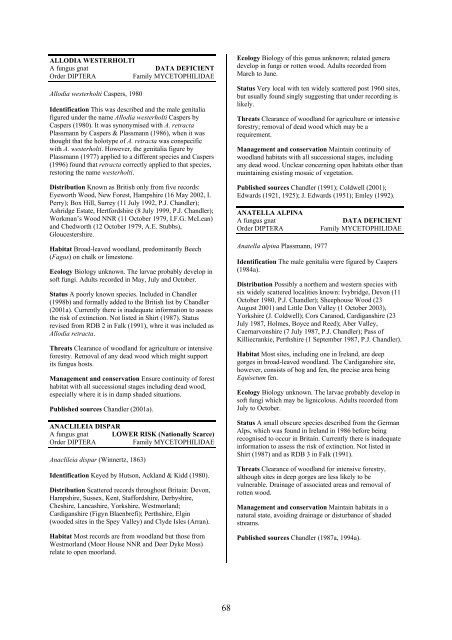Part 2: Nematocera and Aschiza not dealt with by Falk (1991) - JNCC
Part 2: Nematocera and Aschiza not dealt with by Falk (1991) - JNCC
Part 2: Nematocera and Aschiza not dealt with by Falk (1991) - JNCC
You also want an ePaper? Increase the reach of your titles
YUMPU automatically turns print PDFs into web optimized ePapers that Google loves.
ALLODIA WESTERHOLTI<br />
A fungus gnat<br />
DATA DEFICIENT<br />
Order DIPTERA<br />
Family MYCETOPHILIDAE<br />
Allodia westerholti Caspers, 1980<br />
Identification This was described <strong>and</strong> the male genitalia<br />
figured under the name Allodia westerholti Caspers <strong>by</strong><br />
Caspers (1980). It was synonymised <strong>with</strong> A. retracta<br />
Plassmann <strong>by</strong> Caspers & Plassmann (1986), when it was<br />
thought that the holotype of A. retracta was conspecific<br />
<strong>with</strong> A. westerholti. However, the genitalia figure <strong>by</strong><br />
Plassmann (1977) applied to a different species <strong>and</strong> Caspers<br />
(1996) found that retracta correctly applied to that species,<br />
restoring the name westerholti.<br />
Distribution Known as British only from five records:<br />
Eyeworth Wood, New Forest, Hampshire (16 May 2002, I.<br />
Perry); Box Hill, Surrey (11 July 1992, P.J. Ch<strong>and</strong>ler);<br />
Ashridge Estate, Hertfordshire (8 July 1999, P.J. Ch<strong>and</strong>ler);<br />
Workman’s Wood NNR (11 October 1979, I.F.G. McLean)<br />
<strong>and</strong> Chedworth (12 October 1979, A.E. Stubbs),<br />
Gloucestershire.<br />
Habitat Broad-leaved woodl<strong>and</strong>, predominantly Beech<br />
(Fagus) on chalk or limestone.<br />
Ecology Biology unknown. The larvae probably develop in<br />
soft fungi. Adults recorded in May, July <strong>and</strong> October.<br />
Status A poorly known species. Included in Ch<strong>and</strong>ler<br />
(1998b) <strong>and</strong> formally added to the British list <strong>by</strong> Ch<strong>and</strong>ler<br />
(2001a). Currently there is inadequate information to assess<br />
the risk of extinction. Not listed in Shirt (1987). Status<br />
revised from RDB 2 in <strong>Falk</strong> (<strong>1991</strong>), whre it was included as<br />
Allodia retracta.<br />
Threats Clearance of woodl<strong>and</strong> for agriculture or intensive<br />
forestry. Removal of any dead wood which might support<br />
its fungus hosts.<br />
Management <strong>and</strong> conservation Ensure continuity of forest<br />
habitat <strong>with</strong> all successional stages including dead wood,<br />
especially where it is in damp shaded situations.<br />
Published sources Ch<strong>and</strong>ler (2001a).<br />
ANACLILEIA DISPAR<br />
A fungus gnat LOWER RISK (Nationally Scarce)<br />
Order DIPTERA<br />
Family MYCETOPHILIDAE<br />
Anaclileia dispar (Winnertz, 1863)<br />
Identification Keyed <strong>by</strong> Hutson, Ackl<strong>and</strong> & Kidd (1980).<br />
Distribution Scattered records throughout Britain: Devon,<br />
Hampshire, Sussex, Kent, Staffordshire, Der<strong>by</strong>shire,<br />
Cheshire, Lancashire, Yorkshire, Westmorl<strong>and</strong>;<br />
Cardiganshire (Figyn Blaenbrefi); Perthshire, Elgin<br />
(wooded sites in the Spey Valley) <strong>and</strong> Clyde Isles (Arran).<br />
Habitat Most records are from woodl<strong>and</strong> but those from<br />
Westmorl<strong>and</strong> (Moor House NNR <strong>and</strong> Deer Dyke Moss)<br />
relate to open moorl<strong>and</strong>.<br />
Ecology Biology of this genus unknown; related genera<br />
develop in fungi or rotten wood. Adults recorded from<br />
March to June.<br />
Status Very local <strong>with</strong> ten widely scattered post 1960 sites,<br />
but usually found singly suggesting that under recording is<br />
likely.<br />
Threats Clearance of woodl<strong>and</strong> for agriculture or intensive<br />
forestry; removal of dead wood which may be a<br />
requirement.<br />
Management <strong>and</strong> conservation Maintain continuity of<br />
woodl<strong>and</strong> habitats <strong>with</strong> all successional stages, including<br />
any dead wood. Unclear concerning open habitats other than<br />
maintaining existing mosaic of vegetation.<br />
Published sources Ch<strong>and</strong>ler (<strong>1991</strong>); Coldwell (2001);<br />
Edwards (1921, 1925); J. Edwards (1951); Emley (1992).<br />
ANATELLA ALPINA<br />
A fungus gnat<br />
Order DIPTERA<br />
Anatella alpina Plassmann, 1977<br />
DATA DEFICIENT<br />
Family MYCETOPHILIDAE<br />
Identification The male genitalia were figured <strong>by</strong> Caspers<br />
(1984a).<br />
Distribution Possibly a northern <strong>and</strong> western species <strong>with</strong><br />
six widely scattered localities known: Ivybridge, Devon (11<br />
October 1980, P.J. Ch<strong>and</strong>ler); Sheephouse Wood (23<br />
August 2001) <strong>and</strong> Little Don Valley (1 October 2003),<br />
Yorkshire (J. Coldwell); Cors Caranod, Cardiganshire (23<br />
July 1987, Holmes, Boyce <strong>and</strong> Reed); Aber Valley,<br />
Caernarvonshire (7 July 1987, P.J. Ch<strong>and</strong>ler); Pass of<br />
Killiecrankie, Perthshire (1 September 1987, P.J. Ch<strong>and</strong>ler).<br />
Habitat Most sites, including one in Irel<strong>and</strong>, are deep<br />
gorges in broad-leaved woodl<strong>and</strong>. The Cardiganshire site,<br />
however, consists of bog <strong>and</strong> fen, the precise area being<br />
Equisetum fen.<br />
Ecology Biology unknown. The larvae probably develop in<br />
soft fungi which may be lignicolous. Adults recorded from<br />
July to October.<br />
Status A small obscure species described from the German<br />
Alps, which was found in Irel<strong>and</strong> in 1986 before being<br />
recognised to occur in Britain. Currently there is inadequate<br />
information to assess the risk of extinction. Not listed in<br />
Shirt (1987) <strong>and</strong> as RDB 3 in <strong>Falk</strong> (<strong>1991</strong>).<br />
Threats Clearance of woodl<strong>and</strong> for intensive forestry,<br />
although sites in deep gorges are less likely to be<br />
vulnerable. Drainage of associated areas <strong>and</strong> removal of<br />
rotten wood.<br />
Management <strong>and</strong> conservation Maintain habitats in a<br />
natural state, avoiding drainage or disturbance of shaded<br />
streams.<br />
Published sources Ch<strong>and</strong>ler (1987a, 1994a).<br />
68
















